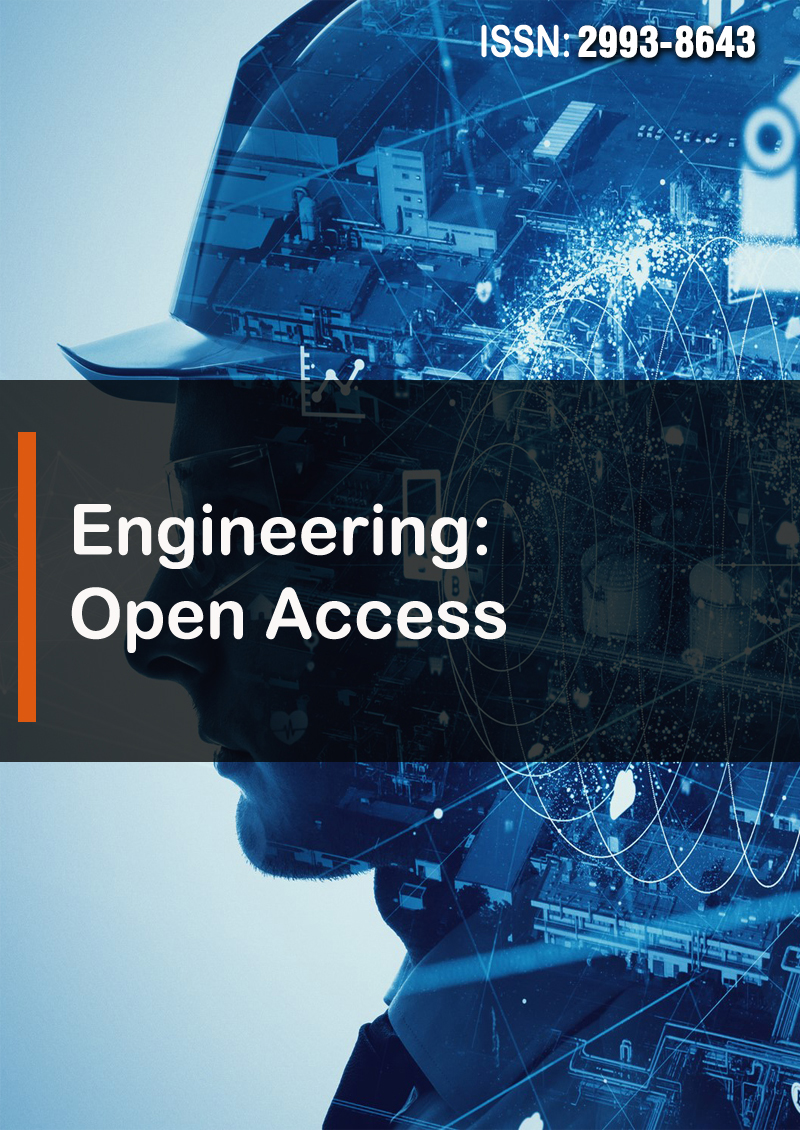Research Article - (2024) Volume 2, Issue 5
Review of Electric Vehicle-To-Grid (V2g) Technology
2Department of Electrical and Communication Engineering, Masinde Muliro University of science and Tec, South Africa
Received Date: Nov 07, 2024 / Accepted Date: Dec 09, 2024 / Published Date: Dec 12, 2024
Copyright: ©2024 Kinoti Emmanuel, et al. This is an open-access article distributed under the terms of the Creative Commons Attribution License, which permits unrestricted use, distribution, and reproduction in any medium, provided the original author and source are credited.
Citation: Emmanuel, K., Michael, J. (2024). Review of Electric Vehicle-To-Grid (V2g) Technology. Eng OA, 2(5), 01-11.
Abstract
Background: Currently, Electric Vehicles are being widely adopted worldwide due to the gradual depletion of conventional sources of energy, environmental pollution, and global climate changes. Integration of Electric Vehicles in power system networks is gradually adopted. The integration is being accompanied by power stability, reliability, and quality issues. Intelligent incorporation of electric vehicles to the grid is required to address these challenges. Electric vehicles offer the potential to gradually decrease carbon emissions and offer grid supporting services such as active power regulation, reactive power support, and load balancing to the power grid. Electric Vehicles possess unique property as a dynamic load and flexible distributed energy storage device. Electric vehicle support services for the power grid act on balancing the power exchange rate and direction between the electric vehicle battery storage system and the grid. This paper provides an up – to – date comprehensive evaluation of vehicle-to-grid technologies and associated grid ancillary services that maintain power system stability and reliability.
Keywords
Ancillary Services, Challenges, Distributed Energy, Dynamic Load, Electric Vehicles (Evs), Energy Storage, Plug-In Electric Vehicles, Power Grid, Reliability, Stability, Storage, Vehicle to Grid (V2g)
Introduction
Due to the gradual depletion of conventional sources of energy, environmental pollution, and global climate changes, it has resulted in an increase in promoting the adoption of electric vehicles and renewable energy sources across the world. Since fossil fuels utilized in the transportation sector have been identified as the most significant contributor to carbon emissions and global warming, transportation electrification can potentially solve this problem. Electric vehicles (EVs) technology has evolved with time from the 1800s to date. However, due to fossil fuel affordability, internal combustion (IC) technology advancements, EVs developments were limited. Figure 1 details the milestones of EVs development. The rate of EVs adoption is still low due to several factors; high initial capital cost, battery life span, unavailability of charging stations, and limited range anxiety [1]. Several interventions backed by the government, like enabling policies and incentives, are being provided worldwide to accelerate EVs adoption. Electric vehicles (EVs) can significantly reduce carbon emissions emanating from conventional transportation and power generation sectors. In the last decade, the adoption of Electric Vehicles (EVs) has been increasing worldwide. When the EVs are linked to the grid, they become gridable EVs (GEVs) for dis/charging.
It is estimated that by 2022, EVs will hit above 35 million across the world [3]. During this period, the cost of Battery Electric vehicle (BEV) is estimated to be at par with the internal combustion engine (ICE) vehicle.
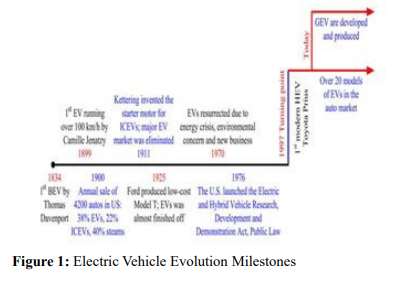
EVs will become a viable option for new car owners, and the adoption will increase. It is projected that plug-in Electric Vehicles (PEVs) will dominate the personal mobility transportation method by 2030. The expanded market for EVs has been a crucial element for the world automotive sector. Countries globally are keen to promote the penetrations of PEVs due to the benefits associated with electric mobility like energy security, environmental, and socio-economic.

In, EVs' total number is projected to be nearly 130 million by the year 2030, based on the International Energy Agency (IEA) [2].
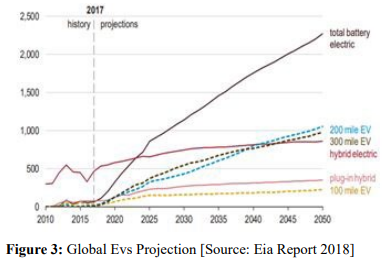
Plug-In Electric Vehicles Impact on Power System
The widespread adoption of PEVs presents social, environmental, and economic benefits. However, a critical challenge associated with PEVs is that their high penetration causes congestion of the distribution network and demand-supply imbalance to the power grid as detailed by figure 2 [3].
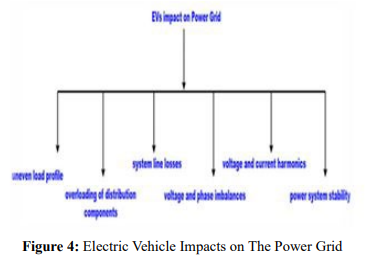
Load Profile
The smart grid Load profile dominated by EVs is determined by the number of connected EVs, Charging period, and charging characteristics. Research on the effects of massive employment of PEVs on the consumer side has been extensively covered. In, EVs load with dump charging contribute to an upsurge in load profile leading to grid instability [4]. This phenomenon can also be addressed by the use of efficient and intelligent charging schemes that balances EVs load demand and power supply. In conclusion, the Intensive deployment of EVs has a ripple effect on the grid's peak demand since the charging of substantial EVs will raise the maximum demand of the power grid.
System Overload
Electric power flows from generating plants and energy storage systems to distribution systems for EVs charging. Power system distribution components like transformers and conductors have technical limits. Present elements are not able to handle the additional unpredictable load for charging a huge number of EVs fleet. This constraint is one of the biggest challenges in the mass adoption of EVs at the commercial level. Any future grid with the substantial connection of EVs must adopt different configurations to cater to EVs charging while checking its parameter limits and component loadings. EVs are dynamic and stochastic loads that magnify the overall burden of network components and directly affect the entire grid system (transformers, lines, and protective gears) [5]. Component overloading can be checked by intelligent EVs charging and discharging and maintaining the desired level's system parameters.
System Losses
An increased number of EVs has an adverse effect on power grid parameters (current, voltage, and power flow patterns). The power system components like distribution transformers and cables will be constrained due to overloading. Uncoordinated and fast charging of EVs is a significant cause of overloading and system losses [6-9]. Smart and Coordinated dis/charging method is the appropriate way to address line losses. Since EVs can play the distributed generation/storage unit's role, its integration to the power system network can reduce line losses and boost grid stability. Power line losses arise from EVs charging, as expressed by the equation below

Voltage Stability
Uncoordinated charging brings about voltage deviation from the permissible limits. This deviation can be contributed by an overflow of current, imbalance of power flow (both active and reactive power) due to low impedance by the feeder lines, and increased load emanating from EVs. Shunt capacitors and flexible alternating current transmission system (FACTS) devices are mostly used to regulate power flow at the distribution network. Limitation of current flow maintains voltage profile within the allowable range, enhancing power quality, increased system capacity, and healthy voltage profile at the consumer end to avoid power surges [10]. Voltage profile maintenance can be achieved by considering several factors like network quality, EVs charging pattern, penetration level, and battery technical limits. Development in Vehicle to Grid (V2G) technology has converted electric vehicles to be possible distributed energy resources (DER). An electric vehicle has a property of acting as a flexible load or as dynamic dispatchable energy storage or generating system; charging or discharging part of it stored energy back to the grid, leading to the V2G concept [11].
If EVs' deployment is uncoordinated, their impact on the power grid is equivalent to a bulk non-linear load resulting in system imbalance and distribution grid congestion [12]. This uncoordinated EVs integration to the power grid can result in:
• Reduced system stability,
• Reliability and efficiency,
• Power quality challenges, such as voltage flickers, harmonics, voltage imbalances and
• Power losses.
EVs dis/charging behaviors make it possible to achieve grid services through controlling and scheduling. By adopting bidirectional smart charging control strategies, there is a possibility of integrating EVs into the power system network as a distributed energy storage system for grid support.
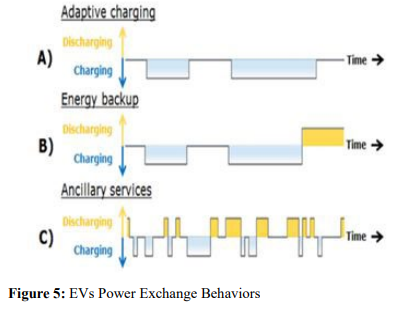
Figure 5 shows that the Adaptive charging mode is regulated based on several factors like energy cost and time, meaning that charging is delayed or advanced. It is also referred to as the smart charging concept. The energy backup concept refers to charging a certain quantity of energy to be fed back to the grid when needed. Ancillary services mode covers continuous charging and discharging power to balance the grid operations. The above operations may be smartly deployed in isolation or combination for various grid support services. EVs charging loads differ from other loads of similar power ratings (pumps, electric cookers, and boilers). EVs load can be regulated based on mobility and grid constraints. This regulation eliminates the need for grid expansion through shifting dis/charging during peak and off-peak periods. The main objectives of carrying out this control action are to minimize the power network's impact, minimize the cost of grid operation, and decarbonization [13]. The possibility to shift the EVs battery charging action in the power grid allows the minimization of distribution network reinforcement. EVs application to offer support to the power grid has been noted before in [14-17]. Previous studies have established that V2G is technically and economically viable. EVs ability to be used as a dynamic and flexible energy storage/generator device, they have the potential to deliver the following grid support services [18- 20]:
• Dynamic voltage control.
• Load following.
• Demand-side response (DSR).
• Frequency control
• Support for distributed renewable energy sources.
• Secondary/spinning reserve.
Overview of Power Grid Ancillary Services
Ancillary services refer to functions that aid the power grid to maintain a reliable power transfer. It relates to several extra operations beyond power generation and transmission critical to power grid stability, quality, and power security [21]. Ancillary services maintain the proper power flow and address imbalances between supply and demand; the system recovers after a power system extraordinary event like fault and sudden loss of generation or load [22]. Ancillary services can include:
• Synchronized Regulation: service that addresses short-term changes in electrical imbalances that might affect the power system's stability.
• Contingency Reserves: reserves used to respond to an unexpected failure or outage of a power grid component.
• Black Start Regulation: supplies electricity for system restoration in the unlikely event leading to the entire grid losing power.
• Flexibility Reserves: This is an emerging concept for addressing variability and uncertainty on periods longer than contingency and regulating reserves.
The universal definition, descriptions, and terminologies of ancillary services are found in the literature [23-28]. Four ancillary services: frequency regulation, voltage regulation, black-start service, and special protection systems [29]. Short terminologies comparison between different regions and countries used for frequency regulation are given in [30]. Definition and clear descriptions for ancillary services can vary significantly based on the user. Some definitions dwell on the significance of ancillary services for power security and reliability; others emphasize ancillary services to support power transfer from generation to distribution and uphold power quality. Besides, some definitions limit the application of ancillary services to the power transmission while others incorporate power distribution roles as well.
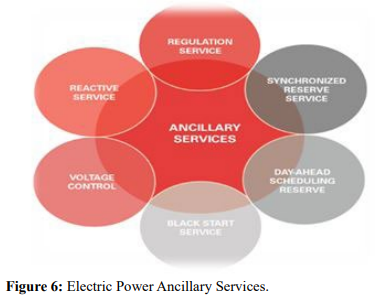
“Ancillary services are all power grid support services required during power transmission or distribution to maintain the stability and reliability of the power system as well as the power quality."
Ancillary services discussed in [32], [33] and [34], three major categories of services emerge in all classifications:
• Frequency control: Service associated with the short-term balance of power and frequency of the power grid. It entails the regulation of frequency and power operating reserves. This is the central service provided by power generators. It can also be availed by flexible loads and energy storage units like batteries.
• Voltage control: Service required for maintaining the power system voltage within the required limits during regular operation and disturbances. This is achieved by balancing of generation and demands of reactive power. Voltage control entails reactive power supply that can be supplied by the dynamic sources like generators, synchronous compensators, and static sources like capacitor banks, static voltage controllers, and FACTS devices and network devices like tap changing transformers available in power grid network [35, 36].
• System restoration: Service required when restoring the power system network to normal operation status after a partial or total blackout. It includes a mainly black start. In this category, it has Spinning and non-spinning reserves.
Electric Vehicle-To-Grid Technology
EVs are driven by electric motors powered by energy stored in energy storage devices (batteries, supercapacitors, fuel cells). Electric Vehicle-to-grid (V2G) technology can be described as a system capable of controlling bi-directional power flow between PEVs and the power grid [37]. V2G system refers to PEVs communication with the power grid to avail grid support services by either discharging to the grid or throttling their charging rate. V2G technology can avail flexible, cheap, and quick-responding energy storage unit of the EVs battery pack. The incorporation of electric vehicles into the power grid is referred to as a V2G integral system. In [38, 39], V2G can provide ancillary services like load leveling, frequency regulation, energy storage, and the spinning reserve. Electric vehicles have in the combined energy storage and power converter systems capable of driving power control strategies. It has been determined that 92% of the total EVs remain parked even during peak time. When EVs are not being operated, the on-board battery energy storage system can be connected to a nearby power grid node through appropriate communication devices to provide grid support services. Types of V2G systems include unidirectional and bi-directional systems. V2G application's substantial benefits can be achieved through a unidirectional V2G system, also referred to as smart charging. Smart charging entails EVs charging time variation for ancillary services provision to the grid. Possible applications of this system of V2G include absorption excess renewable generation, EVs charge rate variation to avail frequency regulation, or load management services.
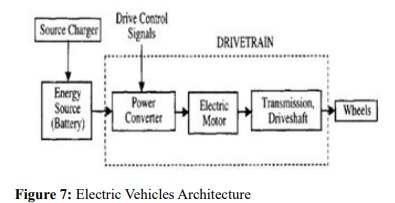
EVs can be categorized based on their architecture, design, functionality, distance range, and fuel consumption. EVs can be classified into two broad groups [40] and [41].
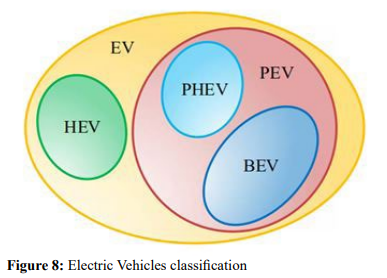
Hybrid Electric Vehicles (HEVs)
They do not utilize energy from external sources like the power grid. The battery storage system is of low-capacity. This dramatically limits distance range and higher speed in electric mode. They cannot be recharged from the grid.
Plug-In Hybrids Evs
They can be plugged into the power grid for battery charging. They are a dual-fuel type of EV close to Hybrid EVs with additional recharging features. They possess a medium-capacity storage battery system that allows the vehicle, in all-electric mode, to cover a range of several dozen kilometers. This model of EVs offers improved performance, increased efficiency, and reduced carbon emissions. This type of EV has different configurations: serieshybrid, parallel hybrid, or combined parallel-series configuration, also referred to as power split.
Battery Electric Vehicles (Bevs)
They operate exclusively on the electricity stored in a highcapacity battery storage system, which can be recharged from the grid. Depending on battery storage capacity, they can cover a distance of 100 to 400 km. It is an absolute non-emission type of EV. The significant issues associated with BEVs include high initial cost, limited mileage range, and a long period of charging and battery degradation.
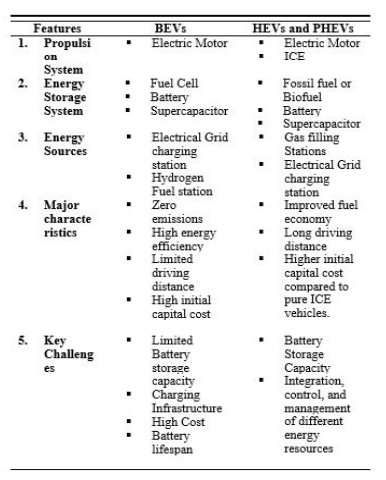
Generally, PEVs utilizes battery energy as its primary power source. PEVs technological superiority is the capability of driving in various energy modes: Charge depleting operation mode power exclusively by the energy stored by the battery pack. The second mode is charge sustaining mode; the battery's recharging is done regularly to maintain the state-of-charge (SOC) level within the driving period. The two ways can be used concurrently to realize the maximum advantage and potential of PEVs fully.The driving range of PEVs is determined by the manufacturer, terrain, temperature, and the model.
Power Flow Schemes in V2g
PEV charging is cyclical, variable, and unpredictable since it behaves as a dynamic load. Suppose a substantial number of PEVs are connected to the grid in the same period in an uncoordinated manner. In that case, the charging may be random hence impacts the grid, particularly during peak times.
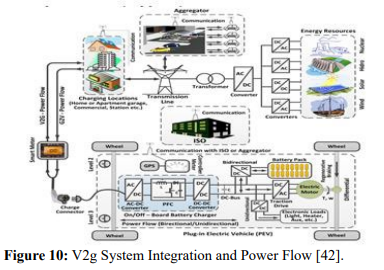
Uncoordinated PEVs charging bring about load imbalances, power losses, and voltage deviations in distributions network [43]. Coordinated charging schemes for EVs can be grouped into decentralized and centralized methods.
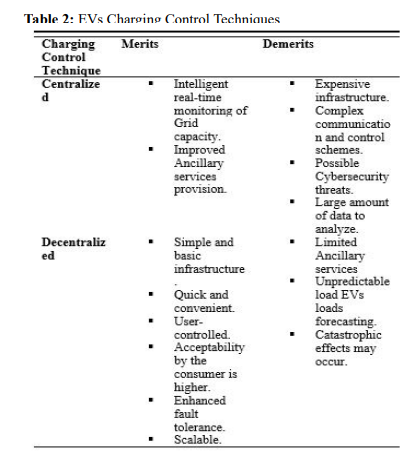
For decentralized (distributed) charging, EVs owner determines charging time. In a centralized method, a center is established to collect information about the power grid status, demand, and supply to aid decisions on charging and discharging control of PEVs.
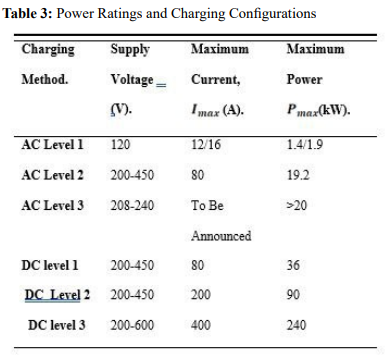
V2g Unidirectional Power Flow
Unidirectional power flow refers to a single direction of power flow between the grid and an EV. It is preferred because of its simple infrastructure and low cost of implementation. This power flow method is specifically used to charge the EVs battery. This type of power flow introduces the possibility of utilizing simple coordination schemes. This method does not present additional degradation for batteries since it does not discharge to the grid. Power flow strategies in EVs charging must be smart to encourage V2G technology adoption by achieving maximum benefits like minimizing the cost of charging and maintaining the health power grid.
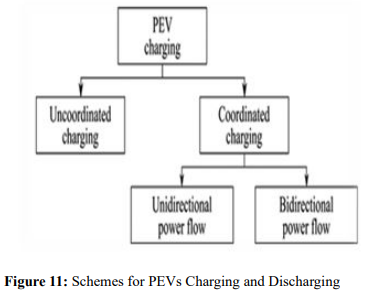
V2g Bi-Directional Power Flow
This power flow mode refers to where power flows in both directions between an EV and the power grid. It is more advantageous than unidirectional power flow in several aspects, but it involves higher costs than unidirectional power flow. It provides the ability to adopt different charging strategies [44]. This method incorporates both AC/DC and DC/DC converters. To realize this type of power flow, bi-directional communication is necessary to provide ancillary services and distributed energy sources entry support. This method introduces additional degradation of the battery storage system due to the discharge cycles.
Owing to the EV battery's limited storage capacity, Individual PEV has almost no impact on the grid. Thus, the V2G design is aimed at a group of PEVs and their distribution of electrical energy between the grid and the PEVs. The V2G architecture has distinct features for the functioning of the power grid.
• Consists of a substantial number of PEVs.
• V2G might use smart buildings, parking spaces, and quick energy swap charging points.
• PEVs aggregators are recommended for implementation.
• The optimization techniques for the V2G system are robust, flexible, and practicable.
Electric Vehicle-To-Grid Benefits
Generally, EVs present several advantages, including improved system efficiency, reduction in the dependence of fossil fuels (energy security), and decarbonization. Broad adoption and smart integration of PEVs have excellent benefits in energy security, a cleaner environment, and the socio-economic sphere. Considering various types of distributed energy sources, EVs possess unique potential. The EV has superior and outstanding properties that enhance its usefulness in smart grid applications (46).
• It is considered a large load compared to other domestic loads at the lowest point of the power distribution network.
• The highly dynamic and flexible grid-connected load is available for longer hours.
• Fast-response storage/generating unit with embedded energy storage and capabilities of bi-directional power flow (V2G).
The above characteristics can be utilized to support a set of power and energy exchanges useful to the operations of power system networks.
Electric vehicles integrated into the power distribution network provide several potential opportunities for supporting grid operation with both active power and reactive power control capability. Power control capabilities support load balancing, filtering harmonics, peak load shaving, reducing operating costs, improving load factors, reducing carbon emissions, and balancing variable renewable energy resources (RES) [47].
When the V2G system is configured to be bi-directional, it provides the potential for desirable quality grid support services, improved voltage regulation, and frequency control, maintaining peak power, load management, and efficient spinning availability reserves [48]. An electric vehicle can be used separately or aggregated to make a sizeable group of EVs, which is a more significant and more convenient load for the grid Aggregated EVs act as a distributed energy source (energy storage device) to provide grid support services & spinning reserve [49]. Instead of reinforcing the grid by the oversizing, an appropriate solution of using the ancillary services provided by the actively controlled EVs connected in the grid emerges. From the V2G technology, ancillary services could be grouped into energy and power services. In particular, energy services require significant energy to be delivered or absorbed by the service supplier. Hence, energy is purchased and sold back to the grid as needed. Power services entail a large power demand, with negligible energy exchanges.
EVs can offer grid ancillary services, as listed below [50-52].
Load Management
The grid load profile consists of peak and non-peak periods. The difference between the baseload and peak load gives the space for reshaping the load profiles by electric vehicles. The difference between peak and off-peak loads is supposed to be bridged for ease of grid operation and reduced operating and capital costs. The V2G system can regulate the system load by discharging the stored energy in EVs batteries to the grid during peak period and charge during off-peak. Intelligent scheduling of discharging and charging helps manage peak load and load curve shifting [53]. The purpose of smart charging is to demand to shift of power and peak load leveling. In, peak power control is the most desired result for load management [54].
Voltage and Frequency Control
This is required to maintain the voltage magnitude within the desired level and maintain system balance. Active and reactive power has a substantial influence on the voltage profile. The V2G application's priority is the regulation services for market value and reduced stress on the power distribution network [54]. Balancing supply & demand for active power is realized through frequency regulation. Conventionally, running large generators provides for frequency regulation, but this is increasing the operational cost. EVs storage batteries offer quick response and flexibility in dis/ charging rates in V2G application, unique features, and an efficient, cost-effective alternative for frequency regulation. Reactive power control is achieved through voltage regulation. Power converters incorporated in EV infrastructure can be used by V2G technology for reactive power corrections by controlling voltage and current angle without affecting the dis/charging process. Typically, a voltage source converter (VSC) at the common point of coupling between the grid and EV is used for voltage regulation. Converters operating with a defined vector control strategy can perform independent control of active and reactive power flow. Charging of EVs battery system can be halted when the grid voltage profile is less to initiate discharge, and charging can commence when the voltage profile is at the desired level [53].
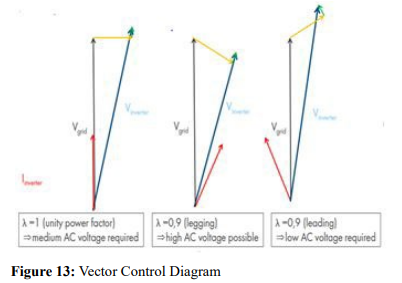
VSC's ability makes it suitable for connection to weak AC grids, especially the ones without local voltage sources. The required converter voltage depends more on reactive power needs.
Reserve
In most cases, both regulation and reserve service appears to be near similar grid support services. Regulation has to offer support to the grid in real-time continuously. Reserve usually consists of an extra generating capacity that must be set aside to compensate for sudden power loss or demand increase in the power grid. Reserve services are generally grouped based on response time:
• Supplementary reserve; whose response time ranges from 5 to 30 minutes,
• Spinning reserve, whose response time ranges from a few seconds to 10 minutes.
• Backup reserve; whose availability is not quick but can operate over a long period.
Generally, the spinning reserve must be able to respond very quickly [44]. The possibility of providing spinning or backup reserve depends on the stored energy availability of EVs. In particular, a small number of EVs cannot offer large amounts of energy, but can just contribute to spinning reserve.
Renewable Energy Storage and Reserve
The most crucial role for V2G application may be in supporting renewable energy generators. Renewable energy sources like wind turbines and solar photovoltaics (PV) will be widely adopted soon [61]. Renewable energy sources penetration at a low level can be handled by existing grid strategies to balance the fluctuations. However, if the penetration exceeds 20% of the connected supply, additional resources and schemes are required to handle power fluctuations [52]. The EVs having V2G technology system offers a source of power backup for intermittent sources of power like wind and solar by providing the balance [45]. A significant challenge associated with renewable energy resources is its intermittency in generation and energy storage. If RES's power is higher than the demand, centralized power generators should decrease the production or curtail distributed generator units for balance restoration. Power backup in the V2G application can be availed by the fuel cell electric vehicles (fuel cell and hybrid running motor-generator). Energy Storage can be provided by the battery pack in PEVs and PHEVs.
EVs can store excess energy from RES for driving or providing power to the grid when the demand is high. When EVs have robust power converters, intelligent and smart coupling to the grid, and proper charger control, EVs act as stored energy resources/devices and serve as a secondary reserve. Intelligent connection to the grid and smart communication between EVs and the grid forms the crucial part of V2G technology. Energy storage has attracted a lot of research since it can provide an opportunity during lowcost energy generation periods. V2G can play a crucial role in supporting renewable energy in emerging power markets. V2G can address output fluctuations associated with renewable energy sources like wind farms and solar energy plants.
Environmental Aspect
Carbon emissions from the transportation sector are huge and growing at a fast rate compared to other areas. These emissions are directly linked to fossil-based fuels like diesel. It is now established that EVs wide adoption can substantially reduce carbon emissions. In, PHEVs can reduce pollutant emissions linked to the automobile industry. By incorporating the V2G application concept, the reductions can be much higher [51]. The charging action of the EVs determines the decrease in carbon emissions. In cases with substantial penetration of PEVs, carbon emissions reduction through lowering overreliance on fossil fuel propelled vehicles. In, 32% greenhouse gas reduction is achieved by adopting PHEVs [52]. However, power generation from less or non-pollutant must be utilized to accomplish the reduction margin. It is has been proved that the PEVs adoption wills reduce the carbon emissions to the environment compared to ICE vehicles powered by fossil fuels. However, careful consideration and comparison of overall global emissions reduction that includes available power plants using pollutant sources to meet the power demand are required.
As the power grid becomes greener and clean, EVs will also reduce greenhouse gas emissions (GHG) attributed to fossil fuel combustion due to zero tailpipe pollution. Another crucial benefit of the EVs wide adoption will be scaling down over-reliance on petroleum products imports. Oil production is domiciled in a few countries around the world. This factor has contributed to price fluctuations and production unpredictability. Power generation can often be derived from available local energy resources, mostly renewable ones. Knocking off fossil fuels out of the energy supply matrix can provide power supply reliability, quality, and security.
Electric Vehicle-To-Grid Challenges
While V2G may provide several opportunities for applications, there are existing challenges associated with V2G technology. Major technical challenges include the following:
Scalability
V2G technology requires dedicated lines/stations that would link the EVs to the primary power grid. With the high initial cost of setting up the infrastructure, a high return rate can only be realized if the number of EVs participating is substantial. Suppose the available number of EVs involved is massive. In that case, the average cost of the infrastructure decreases gradually. The capacity of power generation and storage increases gradually.V2G system benefits can only be realized in large-scale EVs deployment.
Charge Unpredictability
V2G technology is usually configured to utilize stored energy in EVs battery system for power supply during peak periods. This may exhaust /discharge the energy stored in EVs, resulting in mobility challenges during operation time.
Reduced Battery Lifespan
The battery life span of EVs relies heavily on its dis/charging cycle. The battery depth of discharge (DOD) must be balanced to maintain the battery system's health. The battery's depth of discharge indicates the percentage of battery that has been discharged relative to the battery's overall capacity. With uncertainty in dis/ charging associated with the grid, an increase in DOD lowers the battery life, presenting additional costs in V2G participating. The expected average cycles of a battery are related to the DOD, as shown in the figure below.
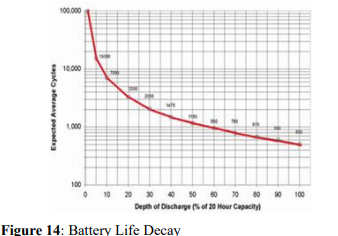
From figure 14, if the EVs battery initial state of DOD is 20%, the expected average cycles are 3300. During power discharge to the grid, its DOD increases, gradually reducing the expected average cycles. The analysis of DOD vs. Cycles for major three EVs batteries (Lithium-ion, Lead-acid, Nickel-metal hydride (NiMH)) is shown in figure 15. Continuous and uncontrolled dis/ charge results in battery heating up. The level of heat in the battery determines its operation efficiency. If the rate of dis/charge is high, the heat generated increases, leading to lower operating efficiency. If this is prolonged, the battery life is affected negatively in the long run.
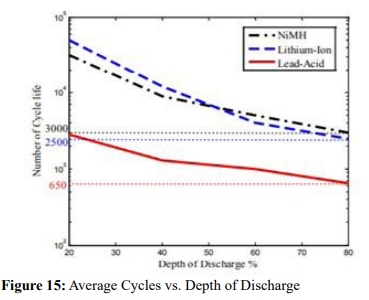
Other non- technical challenges include;
• Economic uncertainties brought about by the abolishment of incentives, price of petroleum products, and EVs ownership overall cost.
• Individual owner reservations especially range limit, cost, and new technology awareness and acceptance.
• Cultural and Social factors.
Conclusions and Future Research Aspects
This paper provides an up-to-date comprehensive evaluation of vehicle-to-grid technologies. EVs impacts on the power grid, prospects, and barriers are analyzed along with an emphasis on the provision of ancillary services. Electric vehicles are a potential solution to the spike in the GHG problem. Besides, EVs can act as a dynamic energy storage system through the use of V2G technology. This unique characteristic is vital for providing grid support services. The analysis shows that while there are plenty of studies in this field, few limitations need to be explored. Some future paths for research are proposed as follows:
The intelligent scheduling, charging algorithms and schemes. The EVs charging must be modeled to be more robust, with a wide array of charging power schemes, battery-swapping, optimal charge points, and ancillary support services. Further studies to establish computational burden and performance balance ought to be undertaken.
Peer-to-Peer V2G power transactions. More research is required on peer-to-peer or charging schemes to encourage all EVs aggregators to trade energy. Trading could even operate regardless of the direct grid influence. The price relay in the central power station cannot impact transactive trading output as it affects energy scheduling and trading in existing systems.
Renewable energy-based EVs charging stations. With wind and solar EVs charging feasible solutions to emission problems, more study is required to establish large scale commercial and technical aspects. Analysis of impact and communication with the power distribution network should be examined.
References
1. Marano, V., & Rizzoni, G. (2008, September). Energy and economic evaluation of PHEVs and their interaction with renewable energy sources and the power grid. In 2008 IEEE International Conference on Vehicular Electronics and Safety (pp. 84-89). IEEE.
2. Kempton, W., & TomiÄ?, J. (2005). Vehicle-to-grid power implementation: From stabilizing the grid to supporting large- scale renewable energy. Journal of power sources, 144(1), 280-294.
3. Longo, M., Foiadelli, F., & Yaïci, W. (2018). Electric vehicles integrated with renewable energy sources for sustainable mobility. New trends in electrical vehicle powertrains, 10, 203-223.
4. Park, W. J., Song, K. B., & Park, J. W. (2013). Impact of electric vehicle penetration-based charging demand on load profile. Journal of Electrical Engineering and Technology, 8(2), 244-251.
5. Yao, L., Lim, W. H., & Tsai, T. S. (2016). A real-time charging scheme for demand response in electric vehicle parking station. IEEE Transactions on Smart Grid, 8(1), 52-62.
6. Habib, S., Kamran, M., & Rashid, U. (2015). Impact analysis of vehicle-to-grid technology and charging strategies of electric vehicles on distribution networks–a review. Journal of Power Sources, 277, 205-214.
7. Shaaban, M. F., Eajal, A. A., & El-Saadany, E. F. (2015). Coordinated charging of plug-in hybrid electric vehicles in smart hybrid AC/DC distribution systems. Renewable Energy, 82, 92-99.
8. Un-Noor, F., Padmanaban, S., Mihet-Popa, L., Mollah, M. N., & Hossain, E. (2017). A comprehensive study of key electric vehicle (EV) components, technologies, challenges, impacts, and future direction of development. Energies, 10(8), 1217.
9. Dharmakeerthi, C. H., Mithulananthan, N., & Saha, T. K. (2011, November). Overview of the impacts of plug-in electric vehicles on the power grid. In 2011 IEEE PES Innovative Smart Grid Technologies (pp. 1-8). IEEE.
10. Farag, H. E., & El-Saadany, E. F. (2011, July). Voltage regulation in distribution feeders with high DG penetration: From traditional to smart. In 2011 IEEE Power and Energy Society General Meeting (pp. 1-8). IEEE.
11. Kempton, W., & Letendre, S. E. (1997). Electric vehicles as a new power source for electric utilities. TransportationResearch Part D: Transport and Environment, 2(3), 157-175.
12. Clement-Nyns, K., Haesen, E., & Driesen, J. (2009). The impact of charging plug-in hybrid electric vehicles on a residential distribution grid. IEEE Transactions on power systems, 25(1), 371-380.
13. Harb, A., & Hamdan, M. (2017, March). Power quality and stability impacts of Vehicle to grid (V2G) connection. In 2017 8th International Renewable Energy Congress (IREC) (pp. 1-6). IEEE.
14. Kempton, W., & Kubo, T. (2000). Electric-drive vehicles for peak power in Japan. Energy policy, 28(1), 9-18.
15. TomiÄ?, J., & Kempton, W. (2007). Using fleets of electric- drive vehicles for grid support. Journal of power sources, 168(2), 459-468.
16. Aziz, M., Oda, T., Morihara, A., Murakami, T., & Momose, N. (2014, February). Utilization of EVs and their used batteries in factory load leveling. In ISGT 2014 (pp. 1-5). IEEE.
17. Aziz, M., Oda, T., & Kashiwagi, T. (2015). Extended utilization of electric vehicles and their re-used batteries to support the building energy management system. Energy Procedia, 75, 1938-1943.
18. Bollen, M. H., Zhong, J., Zavoda, F., Meyer, J., McEachern, A., & Córcoles López, F. (2010). Power quality aspects of smart grids. In International Conference on Renewable Energies and Power Quality (ICREPQ'10), Granada 23-25 March, 2010 (pp. 1-6).
19. Kempton, W., & TomiÄ?, J. (2005). Vehicle-to-grid power implementation: From stabilizing the grid to supporting large- scale renewable energy. Journal of power sources, 144(1), 280-294.
20. Rezaee, S., Farjah, E., & Khorramdel, B. (2013). Probabilistic analysis of plug-in electric vehicles impact on electrical grid through homes and parking lots. IEEE Transactions on Sustainable Energy, 4(4), 1024-1033.
21. Yang, B., Li, W., Zhao, Y., & He, X. (2009). Design and analysis of a grid-connected photovoltaic power system. IEEE transactions on power electronics, 25(4), 992-1000.
22. Cipriani, G., Di Dio, V., Di Noia, L. P., Genduso, F., La Cascia, D., Miceli, R., & Rizzo, R. (2013, June). A PV plant simulator for testing MPPT techniques. In 2013 International Conference on Clean Electrical Power (ICCEP) (pp. 482- 489). IEEE.
23. Hirst, E.; Kirby, B. power ancillary services. O R N L /CON- 426, O a k R i d g e National L a b o r a t o r y, Oak Ridge, TN, 2016.
24. Brando, G., Coccia, A., & Rizzo, R. (2004, December). Control method of a braking chopper to reduce voltage unbalance in a 3-level chopper. In 2004 IEEE International Conference on Industrial Technology, 2004. IEEE ICIT'04. (Vol. 2, pp. 975-978). IEEE.
25. Brando, G., & Rizzo, R. (2004, May). An optimized algorithm for torque oscillation reduction in DTC-induction motor drives using 3-level NPC inverter. In 2004 IEEE International Symposium on Industrial Electronics (Vol. 2, pp. 1215-1220). IEEE.
26. Pagano, E., Piegari, L., & Tricoli, P. (2003, November). Approaches to analytical analysis of active filter behaviour. In IECON'03. 29th Annual Conference of the IEEE Industrial Electronics Society (IEEE Cat. No. 03CH37468) (Vol. 3, pp. 2017-2022). IEEE.
27. Brando, G., Dannier, A., & Rizzo, R. (2007, May). A sensorless control of H-bridge multilevel converter for maximum power point tracking in grid connected photovoltaic systems. In 2007 International Conference on Clean Electrical Power (pp. 789-794). IEEE.
28. Rizzo, R., Piegari, L., & Tricoli, P. (2012). A comparison between line-start synchronous machines and induction machines in distributed generation. Prz. Elektrotech, 88, 187- 189.
29. Guttromson, R. T. (2002). Modeling distributed energy resource dynamics on the transmission system. IEEE Transactions on Power Systems, 17(4), 1148-1153.
30. Sortomme, E., & El-Sharkawi, M. A. (2011). Optimal scheduling of vehicle-to-grid energy and ancillary services. IEEE Transactions on Smart Grid, 3(1), 351-359.
31. Kuzle, I., Bosnjak, D., & Tesnjak, S. (2007, June). An overview of ancillary services in an open market environment. In 2007 Mediterranean Conference on Control & Automation (pp. 1-6). IEEE.
32. Marano, V., & Rizzoni, G. (2008, September). Energy and economic evaluation of PHEVs and their interaction with renewable energy sources and the power grid. In 2008 IEEE International Conference on Vehicular Electronics and Safety (pp. 84-89). IEEE.
33. Pani, P., Athreya, A. R., Panday, A., Bansal, H. O., & Agrawal, H. P. (2015, March). Integration of the vehicle-to- grid technology. In 2015 International Conference on Energy Economics and Environment (ICEEE) (pp. 1-5). IEEE.
34. Kempton, W., & TomiÄ?, J. (2005). Vehicle-to-grid power fundamentals: Calculating capacity and net revenue. Journal of power sources, 144(1), 268-279.
35. Aziz, M., & Oda, T. (2016). Load levelling utilizing electric vehicles and their used batteries. Modeling and Simulation for Electric Vehicle Applications, 125-147.
36. Tuttle, D. P., & Baldick, R. (2012). The evolution of plug- in electric vehicle-grid interactions. IEEE Transactions on Smart Grid, 3(1), 500-505.
37. Saldanha, J. J. A., Dos Santos, E. M., De Mello, A. P. C., & Bernardon, D. P. (2016). Control strategies for smart charging and discharging of plug-in electric vehicles. Smart Cities Technologies, 1, 121-141.
38. Wang, X., & Liang, Q. (2015). Energy management strategy for plug-in hybrid electric vehicles via bidirectional vehicle- to-grid. IEEE Systems Journal, 11(3), 1789-1798.
39. Yao, L., Damiran, Z., & Lim, W. H. (2017). Optimal charging and discharging scheduling for electric vehicles in a parking station with photovoltaic system and energy storage system. Energies, 10(4), 550.
40. Andersen, P. B., Marinelli, M., Olesen, O. J., Andersen, C. A., Poilasne, G., Christensen, B., & Alm, O. (2014, October). The Nikola project intelligent electric vehicle integration. In IEEE PES Innovative Smart Grid Technologies, Europe (pp. 1-6). IEEE.
41. White, C. D., & Zhang, K. M. (2011). Using vehicle-to-grid technology for frequency regulation and peak-load reduction. Journal of Power Sources, 196(8), 3972-3980.
42. Guille, C., & Gross, G. (2009). A conceptual framework for the vehicle-to-grid (V2G) implementation. Energy policy, 37(11), 4379-4390.
43. Mets, K., Verschueren, T., Haerick, W., Develder, C., & De Turck, F. (2010, April). Optimizing smart energy control strategies for plug-in hybrid electric vehicle charging. In 2010 IEEE/IFIP network operations and management symposium workshops (pp. 293-299). Ieee.
44. Kempton, W., & Kubo, T. (2000). Electric-drive vehicles for peak power in Japan. Energy policy, 28(1), 9-18.
45. De Los Ríos, A., Goentzel, J., Nordstrom, K. E., & Siegert,C. W. (2012, January). Economic analysis of vehicle-to- grid (V2G)-enabled fleets participating in the regulation service market. In 2012 IEEE PES Innovative Smart Grid Technologies (ISGT) (pp. 1-8). IEEE.
46. Kempton, W., & TomiÄ?, J. (2005). Vehicle-to-grid power fundamentals: Calculating capacity and net revenue. Journal of power sources, 144(1), 268-279.
47. Wu, C., Mohsenian-Rad, H., Huang, J., & Jatskevich, J. (2012, January). PEV-based combined frequency and voltage regulation for smart grid. In 2012 IEEE PES Innovative Smart Grid Technologies (ISGT) (pp. 1-6). IEEE.
48. Clement-Nyns, K., Haesen, E., & Driesen, J. (2011). The impact of vehicle-to-grid on the distribution grid. Electric Power Systems Research, 81(1), 185-192.
49. Kuzle, I., Bosnjak, D., & Tesnjak, S. (2007, June). An overview of ancillary services in an open market environment. In 2007 Mediterranean Conference on Control & Automation (pp. 1-6). IEEE.
50. Valsera-Naranjo, E., Martinez-Vicente, D., Sumper, A., Villafafila-Robles, R., & Sudria-Andreu, A. (2011, July). Deterministic and probabilistic assessment of the impact of the electrical vehicles on the power grid. In 2011 IEEE Power and Energy Society General Meeting (pp. 1-8). IEEE.
51. Marano, V., & Rizzoni, G. (2008, September). Energy and economic evaluation of PHEVs and their interaction with renewable energy sources and the power grid. In 2008 IEEE International Conference on Vehicular Electronics and Safety (pp. 84-89). IEEE.
52. Gurkaynak, Y., & Khaligh, A. (2009, February). Control and power management of a grid connected residential photovoltaic system with plug-in hybrid electric vehicle (PHEV) load. In 2009 Twenty-Fourth Annual IEEE Applied Power Electronics Conference and Exposition (pp. 2086-2091). IEEE.


